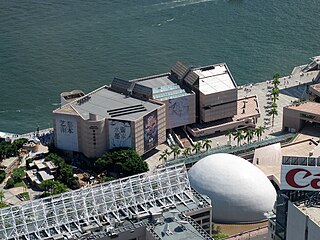
Central is the central business district of Hong Kong. It is located in Central and Western District, on the north shore of Hong Kong Island, across Victoria Harbour from Tsim Sha Tsui, the southernmost point of Kowloon Peninsula. The area was the heart of Victoria City, although that name is rarely used today.

The Hong Kong Museum of History is a museum which preserves Hong Kong's historical and cultural heritage. It is located next to the Hong Kong Science Museum, in Tsim Sha Tsui, Kowloon, Hong Kong.

Tsim Sha Tsui, often abbreviated as TST, is an urban area in southern Kowloon, Hong Kong. The area is administratively part of the Yau Tsim Mong District. Tsim Sha Tsui East is a piece of land reclaimed from the Hung Hom Bay now east of Tsim Sha Tsui. The area is bounded north by Austin Road and in the east by Hong Chong Road and Cheong Wan Road.

The Shanghai Museum is a museum of ancient Chinese art, situated on the People's Square in the Huangpu District of Shanghai, China. Rebuilt at its current location in 1996, it is considered one of China's first world-class modern museums.

The Hong Kong Museum of Art is the main art museum of Hong Kong. It is managed by the Leisure and Cultural Services Department of the Hong Kong Government. A branch museum, the Flagstaff House Museum of Tea Ware, is situated in the Hong Kong Park.

The former Central Police Station of Hong Kong, located at the eastern end of Hollywood Road, in Central, Hong Kong has been redeveloped into a cultural and shopping destination generally called Tai Kwun (大館). It is composed of three declared monuments: the former Central Police Station, former Central Magistracy and Victoria Prison.

The Hong Kong Heritage Discovery Centre is located in the Kowloon Park, Haiphong Road, Tsim Sha Tsui, Kowloon, Hong Kong. The Centre occupies the historic Blocks S61 and S62 of the former Whitfield Barracks at the Kowloon Park.

Possession Street is a street in Sheung Wan, from Queen's Road West to Hollywood Road, on the Hong Kong Island in Hong Kong. The street marks the boundary of Queen's Road West and Queen's Road Central.

Hong Kong Maritime Museum is a non-profit educational institution funded by the international shipping community and the government in Hong Kong. It is located at Central Pier 8, Hong Kong. The museum was reopened to the public in February 2013.

The Hong Kong Correctional Services Museum is a museum in Tung Tau Wan Road, Stanley, Hong Kong. It was originally housed in the Staff Training Institute of the Hong Kong Correctional Services Department.

Asia Art Archive (AAA) is a nonprofit organisation based in Hong Kong which focuses on documenting the recent history of contemporary art in Asia within an international context. AAA incorporates material that members of local art communities find relevant to the field, and provides educational and public programming. In 2016, AAA is one of the most comprehensive publicly accessible collections of research materials in the field, and has initiated about 150 public, educational, and residential programmes.

The "June 4th Museum", organized by the Hong Kong Alliance in Support of Patriotic Democratic Movements in China, is a currently homeless memorial museum of the Tiananmen Square protests of 1989, that occurred in Beijing, China. The first attempt at a permanent home for the collection was in Tsim Sha Tsui Hong Kong, housed in a 1,375 sq ft. space, it opened on 26 April 2014, shortly before the 25th anniversary of the incident.

M+ is a museum of visual culture currently under construction in the West Kowloon Cultural District of Hong Kong. It is scheduled to open in 2019.
Wong Wo Bik is a fine arts photographer and one of the few active female photographers in Hong Kong. She is best known for her photographic documentation of buildings and architecture with historical and cultural significance in Hong Kong. Her work also involves artistic manipulations, as these photographs retell her experience and stories at the sites. In 2013, she received an award from the Hong Kong Women Excellence in the Six Arts, Hong Kong Federation of Women. Wong also has a long and active career as a curator, researcher and art educator.
Wilson Shieh Ka Ho is a mid-career Hong Kong artist. His studio is in the Artistic Community in Fo Tan.
Tsang Kin-Wah is a visual artist based in Hong Kong. His earlier work, particularly his "wallpaper art", was known for its combination of beautiful illustration and painting, and for its use of profane or obscene words. More recently, he has explored topics related to politics and religion via large-form, multi-media installations that combine music, video and light projections.
Ho Sin Tung is a visual artist who lives and works in Hong Kong.
Wong Kit Yi is an artist living and working between Hong Kong and New York. She is known for her research areas, which blends art with science.



















